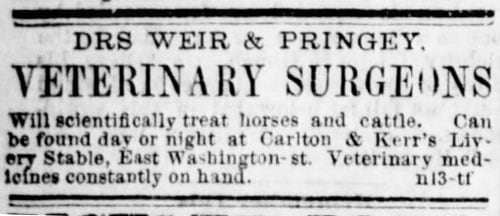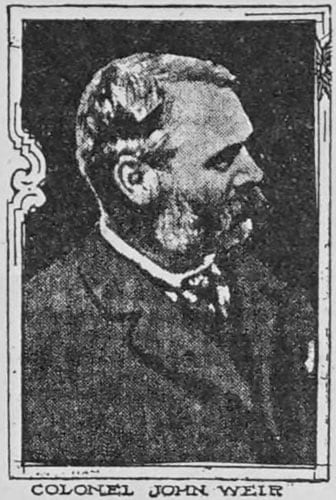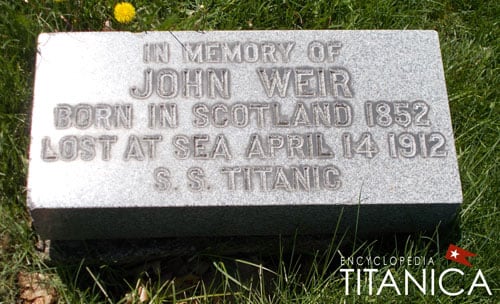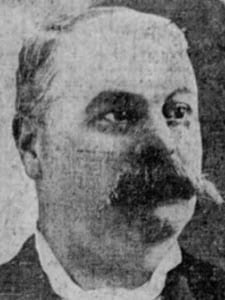"Colonel" John Weir was born in Scotland in 1850.1
John Weir's parents were John (c.1818-1891), a wool weaver, and Jane Gillies (or Gilles, c.1821-c.1881). John Weir Sr. was originally from Galashiels, Selkirkshire, while Jane came from Edinburgh. They married on 24 March 1839 in Warkworth, Northumberland. Their first child Robert was born in Northumberland the following year. In the 1841 census, they were recorded living at Great Tosson, Rothbury, Northumberland. By 1849 the family had moved to Innerleithen, Peedleshire, Scotland.
John Weir's other siblings were Margaret (1849-1941), Jane [I] (1851-1858), Charles (b. 1855), James (1856-1918), Sarah (1858-1939), George (b. 1862) and Jane [II] (b. 1864).
John first appears on the 1851 census as an 11-month-old infant living with his family at an unspecified address in Innerleithen. Tragedy struck in 1858 when his 6-year-old sister Jane died from whooping cough. When the family appeared on the 1871 census living at 6 Dickson Street, Beckhouse in Roxburghshire John was not present at the time and his whereabouts are not known, but he had probably already moved to America.2
He was married at Well Road Presbyterian Church, Moffat, Dumfriesshire, Scotland on 10 November 1873 to Catherine Plant (b. 14 December 1853), a resident of Moffat, but English by birth, hailing from Staffordshire. His occupation at the time was given as 'coachman'. They left almost immediately for America (a letter dated 20 Nov 1878 from John to Catherine refers to the day being the fifth anniversary of their coming to America).
The couple travelled extensively, with Weir working different trades, including as a veterinary surgeon and styling himself Dr John Weir.
By 1875 Weir had moved to Bloomington, Illinois, USA where he operated a veterinary practice, specialising in treating horses, out of a livery stable on East Washington Street. For a short time, he was in partnership with a Dr S. G. Pringey.

The Pantagraph, 15 November 1875
A son, Robert Duncan Weir (known as Robin), was born in Bloomington in 1876 but it appears that for much of the time Catherine and Robin lived away from John (variously back in Scotland, and for a time in Terre Haute, Indiana), while Weir tried to build his business. Letters from Weir to Catherine that have survived detail a seemingly loving relationship but with many financial struggles.
Around 1879 Weir moved west to Sacramento, California, and then San Francisco, reportedly on account of his health, but the state of his marriage may also have been a factor.
In 1880 it was reported in the Bloomington Pantagraph that Catherine had applied for a divorce:
Threw too much crockery
Catharine Weir [sic], the wife of John G. Weir [sic], the well known veterinary surgeon, formerly of this city, alleges that she was married to the defendant in Moffet, Scotland, in 1873, and afterwards emigrated with him to the glorious climate of America, where she lived as a dutiful and faithful wife until the year 1878, when she could no longer stand the barbarous treatment which she received from his hands. He used to throw dinner plates at her head and try to carom upon her shoulders with a heavy whip. He was also guilty of adultery with various women, and neglected to give her and her child proper support. For these violations of domestic felicity she would petition the court to have her relations as his wife forever severed by a proper judicial proceeding.
In 1881 Robert Duncan Weir (Robin) was staying with his maternal grandparents back in Moffat, Scotland. In November 1885, when he was 9, Robin and his mother Catherine arrived in Brisbane aboard the Bulimba, to settle permanently in Queensland, Australia. On 25 April 1887, Catherine married John Howat with whom she produced a daughter Mary (later Mrs Tidemann, 1888-1969); Catherine died on 8 November 1907.
At some point, possibly while he was still married to Catherine, John Weir began a relationship with Harriet "Hattie" Elizabeth Mallinson (b. 1857), a native of West Cornwall, Connecticut. They apparently married on 13 November 1878 in San Francisco (i.e. about two years before Catherine filed for divorce).3 They would have three children: a daughter, Beatrice Mallinson (born 2 February 1880 in San Francisco), a son, Harold Mallison (born in Australia, 22 August 1883); and a daughter, Mary Norton (born 3 August 1885, in London).4
In 1880 or 1881 Weir moved to Honolulu and he seems to have transitioned from veterinary surgery to trading in horses, cattle and sheep. In a 1912 obituary, it was reported that Weir was instrumental in the importation from San Francisco of the first batch of trotting horses to Australia; the horses' names included "Beatrice W." and "Hattie Weir." In 1882, he was a founder member of the Victorian Trotting Club. The newspapers of the time invariably list him as Dr John Weir, though no evidence of formal veterinary training or degree has been found.5
Around this time (September 1882) Dr Weir became involved with a syndicate that proposed to build a private cable tramway in Melbourne, similar to those found in San Francisco.
In November 1882 he was briefly jailed after attempting to leave Victoria while in dispute over the payment for some sheep. After his release, he seems to have returned permanently to the United States and focused his attention increasingly on railway construction, investments, and mining.
Later newspaper reports state that Weir made his fortune in mining in the US and Mexico, working as an engineer and becoming president of the Nevada-Utah Mines & Smelters corporation before he stood down in May 1907 on account of ill health. Weir travelled greatly for business but typically stayed at the Waldorf Hotel in New York, invariably in room 1012, which may have been a private suite.

Waldorf-Astoria Hotel records. Manuscripts and Archives Division. The New York Public Library. Astor, Lenox, and Tilden Foundations.
The basis for his adopting the title "Colonel" is unclear.6,7 According to an obituary in the Salt Lake Tribune (19 Apr 1912) he had been appointed "quartermaster-general" by President McKinley during the Spanish-American War and served in the Philippines. However, very few quartermaster-generals were ever appointed, and Weir's name is not among them. No evidence of formal rank has been found; likely, his work in the Philippines was not military but related to scouting mining and investment opportunities. Whether in the national interest or his business interests is uncertain, but it is known that he had close contacts in the Department of War and State Department and used these to facilitate his travels in the period during and immediately following the war.
The status of John and Hattie's marriage is also unclear. On 30 October 1893, Weir contracted a marriage with Pauline Graham Kelly in Milwaukee, Wisconsin. Kelly was the granddaughter of James Kelly, one of the founders of the Chicago Tribune. Weir's parent's names on the certificate match his, and he is listed as an engineer. However, if this marriage was between the later Titanic passenger and Miss Kelly, it seems to have been extremely shortlived and may have been bigamous if he was still legally married to Hattie Mallinson. Weir's relationship with Pauline remains a mystery, but the Kelly family home address was listed as his address in business correspondence from 1901.
For the last six years of his life, Weir lived in Britain, dividing his time between his home, "Ingleholm," in North Berwick, Lothian, Scotland, and London. However, he frequently returned to Utah and was a member of the Alta Club in Salt Lake City. He was also a life member of the New York Academy of Sciences.
Weir took a keen interest in local affairs in North Berwick and was an active golfer. For many years, well into the 1930s, the Colonel Weir Rose Bowl was awarded as a trophy for women's golf.
In 1909, newspapers reported that he was recovering in London after having been seriously injured in an unspecified accident.

The 1911 British census shows him residing at 229 Piccadilly (just off Piccadilly Circus), West London, and he was described as a retired mining engineer. He appears to have been living with a professional nurse named Kate Carter.
In the weeks before sailing on the Titanic, John Weir had been unsuccessfully trying to sell Ingleholm. At the time, his widowed sister Margaret Hewitt, who was visiting from her home in New York, was occupying it.
His friend, Morris P. Kirk of Salt Lake City, received a letter dated 6 April in which Weir stated that he was going to travel on the Philadelphia and was planning on travelling on to Salt Lake City. Kirk and Weir were then to travel to California to examine some mining areas in the Feather River area. The coal strike postponed the scheduled sailing of the Philadelphia, and so Weir reluctantly transferred to the Titanic.
Before sailing, Weir had been staying at the Waldorf Hotel, as reported in The Globe (16 April 1912); on the night before he checked out to make his journey, he conversed with the hotel manager in that establishment's smoking room. The two men discussed various topics before Weir suddenly exclaimed: "I'm hanged if I'll go tomorrow." Pressed as to the reason for this unexpected remark, he said, "Well, I know it sounds absurd, but I have got a funny feeling about going. I may receive a business message this evening, and if I do, I will not go, although I have booked a first-class passage."
The hotel manager said that Colonel Weir was still uneasy the following day and was further agitated upon waking when he discovered his ewer [water jug] to have broken during the night. Upon leaving the hotel, Weir advised his valet that if he decided to discontinue his journey, he would cable him from Queenstown.
Another premonition appeared in The Journal and Tribune:
Col. Weir, when here last, told friends of his contemplated trip to Europe, and when the question came up concerning some matter of pay, which he was to receive for services rendered in Virginia, he was quoted as having said that that was a matter of small moment, adding, "besides, I am now getting old, and I may be drowned before I get back to America."
Weir boarded the ship in Southampton and was travelling in first class (ticket number 113800, which cost £26, 11s) and was reportedly accompanying Irish passenger Henry Forbes Julian. The Globe (18 April 1912) states that he was also closely associated with Isidor Straus and Benjamin Guggenheim and was hastening to America to complete deals in Alaska and Mexico.
John Weir died in the sinking, and his body, if recovered, was never identified.
"Mrs Weir" reportedly arrived at the Cunard dock to receive news of her husband and fainted twice, such was her grief and had to be carried back to her automobile by policemen.
NORTH BERWICK HOUSEHOLDER A VICTIM
The relatives of Colonel John Weir, who was a passenger on the Titanic, have received the sad news by cable that there is no hope of his safety. Colonel Weir, although an American citizen, was Scottish by birth. He came as a visitor to North Berwick about six years ago, and took up house there, residing at Ingleholm. He had been absent from North Berwick for some time past, but his sister had been staying there. Colonel Weir was of a kindly, generous nature, and was very highly respected in North Berwick district.
Weir left a net estate of £26,876, part of which consisted of stocks and bonds he had on his person aboard Titanic. His son Harold had been appointed the administrator of the estate but sister Beatrice complained he mismanaged the estate leaving her and their mother Hattie "destitute". Then Weir's first son Robert (Robin) claimed himself to be the only legitimate heir of Colonel Weir and attacked the validity of his father's second marriage. Initial reports stated that Hattie's whereabouts were unknown, but evidently, she was eventually located as she claimed the bulk of the estate with the rest divided between the four children.
In 1913 Pauline G. Kelly (whom Weir had married in 1893) arranged for a stone in memory of John Weir, the Titanic victim, to be placed almost adjacent to ones for her parents at Graceland Cemetery, Chicago, Cook County, Illinois, USA (Bellevue Section, Lot 299).

Born in Scotland 1852
Lost at Sea April 14 1912
S.S. Titanic
(Photo courtesy of Robert Lerch)
John Weir's widow Hattie died after being hit by a truck in Manhattan on 4 April 1919 and was buried in North Cornwall Cemetery in Cornwall, Connecticut.
Mrs Weir, a sister of Walter Mallinson, who has been living in New York the past winter, was recently very badly hurt by a heavy auto truck. She was taken to the New York hospital, and apparently was gaining. Her daughter, Mrs. Bedat, was telephoning to her one evening and the next morning received news of her death. The body was brought to West Cornwall on the noon train Monday, for burial at North Cornwall.
His son Robert made his home in Queensland, Australia, where he worked as a farmer and sugar boiler, among other professions. He married Nellie Archer (1883-1969) and raised a large family before his death on 20 July 1946.
His son Harold later became an eminent civil engineer and was married up to four times, first in 1902 to a Canadian Kathryn Wright, then in 1907 to Amy Ruth Fraye (b. 1878), later to Irene Colville, and possibly a fourth time to an Anne, named in a newspaper death notice. He died on 1 November 1960.
His daughter Mary became a nun in Scotland; she died from a stroke in Philadelphia on 3 February 1954.
His daughter Beatrice married first in 1904 to Donald Francis Charles Steuart-Seton, sometime law student, speculator, mining engineer (like his father-in-law), parliamentary candidate for West Islington, gambler, and bankrupt. They had three children: Beatrice Helen Mary Steuart-Seton (1905–1982), Margaret Elizabeth Steuart-Seton (1907–1907), and Ian Grant Francis Steuart-Seton (1913–1983), who later became a priest. Donald died in 1915, aged 43. She remarried the same year in Torrington, Connecticut, USA, to Frank J. Bedat (1888-1962), a carpenter, and they had a daughter, Elizabeth (Betty), in 1916. Beatrice died from the effects of burn injuries on 8 May 1943.
Pauline Graham Kelly was a prominent member of society in Chicago and in later years lived alone and tutored in home economics. She died in 1955 aged 89.

Comment and discuss
Showing 2 posts of 47 total. View all.
Open Thread Leave a Reply